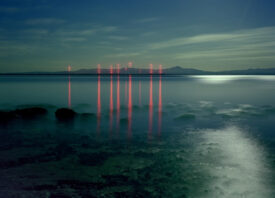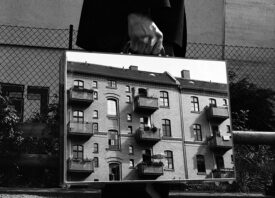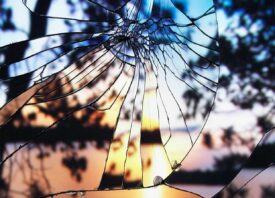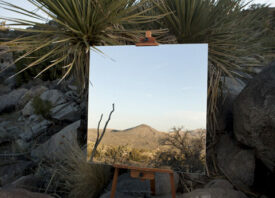Search this site
The Unit Stills Photographer Who Captured Everyone’s Favorite Episode of Black Mirror


It was nighttime in Cape Town, and the photographer David Dettmann had been shooting for five nights straight. He was exhausted, but he had one chance to get his shot of the now-famous car crash scene in the San Junipero episode of Black Mirror. A love story with a twist, San Junipero is largely considered by critics to be the best episode of the series. Even if you haven’t seen it, you might have seen Dettman’s promo shots, featuring actors Gugu Mbatha-Raw and Mackenzie Davis, illuminated by street lights and decked in 1980s costumes.
Dettmann has worked as a photographer in the film industry for decades. While his career has certainly had its fair share of celebrity encounters—he’s photographed Beyoncé, Lady Gaga, Margot Robbie, Olivia Colman, and countless others on the Red Carpet—it’s not all glitz and glamour. For a unit photographer, it’s all about late nights, tight spaces, and even tighter deadlines. “On the last day of Junipero, I was literally falling asleep while standing up, something I didn’t know was possible,” the artist recalls.
But in the end, it’s all worth it for that moment he knows he’s captured something magical. In addition to working on two episodes of Black Mirror and other shows for Netflix, Dettmann has recently worked on television sets for Disney, the BBC, and others. In this interview, he gives us a behind-the-scenes look at a day in the life of a Black Mirror photographer and shares tips for emerging artists.

How and when did you embark on your journey as a unit photographer, and how did you get your foot in the door with studios like WarnerBros and Universal?
“My first introduction into the film industry was through shooting film premieres in London for Warner Bros. My wife was working for WB at the time and changed departments to assist with the premiere of Tim Burton’s version of Charlie and the Chocolate Factory in 2005, starring Johnny Depp.”
What are some of the challenges that come with being a unit photographer, and how do you navigate them? In what ways does this job differ from your other celebrity work (such as red carpets and portraits)?
“The main challenge of unit photography is getting the shots while still remaining inconspicuous and out of the way of all the other crew. The last thing you want to do is distract talent during a difficult scene and bump a camera operator.
“Usually, I’ll find myself tucked up next to the focus puller as the set angles are usually very tight. It’s really important to be super respectful and friendly to all the crew so they give you a gap if you need one.”

Can you tell us a bit about what being a unit photographer entails? I think everyone knows about the behind-the-scenes shots, but you also create a lot of other types of images for advertising/promo, right? What are some things that are included in the job that people might not know about?
“A standard day would be to arrive at the crew call time and to firstly familiarise yourself with the set and scene and then to scout out the angles The brief is determined beforehand by the unit publicist and is usually dependant on when key talent are on set. Once all key talent are on set, there will be a rehearsal. I always try and get a few shots done in rehearsal as there are fewer crew members, such as the boom operator for sound.”
We’d love to know more about your work as a Black Mirror photographer, which included the iconic San Junipero episode. How did you first connect with Netflix?
“Both Black Mirror episodes I worked on were shot in various locations around Cape Town. Netflix was already a London client for whom I’d shoot Red Carpet events. There was a lot of night shooting for San Junipero, which is always a challenge for us stills guys. Video is far more forgiving in low-light situations than stills are. Luckily, technology has really helped us over the years with better sensors and image stabilization, but you still need to be on your A-game at night.”

As a Black Mirror photographer/unit stills photographer for Netflix, what did a day on the set look like for you? Can you walk us through your routine?
“I would arrive at the call time and then run through the call sheet so I am familiar with all the scenes we would be filming that day. I would then cross-reference my brief from the unit publicist so I know exactly what I need to shoot. I would then get my cameras ready and choose the required lenses for the first scene. I always shoot on two cameras so there’s no time wasted on changing lenses. Then shoot the rehearsal and each scene from then on.”

How do you know when you’ve captured something great on set?
“Timing is everything with unit photography, and it takes a lot of patience. But generally, it’s more of a feeling when you know you have the shot.”

How much creative freedom do you usually have on set?
“Unit photographers have a lot of creative freedom and work largely by ourselves. Obviously, the brief from the Unit publicist is key to delivering the shots, but how we get them is up to us.
You’ve been in this industry for decades. How has the role of a unit photographer evolved during that time? Have expectations changed at all?
“Essentially, the role hasn’t changed much at all over the years. The delivery times and deadlines are much tighter now. I always try to get my selection and editing done the same day I shoot; otherwise, you risk falling behind and adding more pressure.
As a Black Mirror photographer and unit stills photographer in general, what advice do you have for emerging photographers who want to get started in this industry? Aside from talent, what does it take to make it?
“Firstly, you need a passion for the film industry. The days on set are long and can wear you down over time. Theatre is a good place to start to learn the craft and is usually much more accessible to most people. From there, try to get on a smaller TV production or even a documentary to start understanding how a set is run and the etiquette required. Ultimately, working with so many talented people on a film set is always inspiring and forces you to constantly evolve and shape your craft.”
Further reading:
• Surreal Photography: 12 Creative Techniques to Try
• 15 Pieces of Advice for Emerging Photographers



